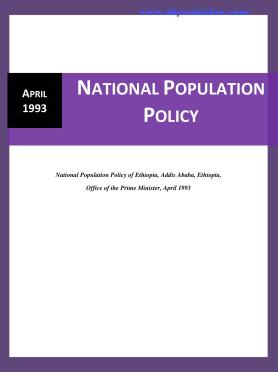Population Policy (English)
Population Policy (English)
The combined forces of political turmoil, adverse climatic conditions and an all round decline in productivity in all sectors of the economy reduced the population of Ethiopia into a state of abject poverty. There has not been any time, since the early 1980s when the economy grew at a rate higher than that of the population. GDP grew at an average rate of 2.7% between 1965 and 1980 and at 1.9% between 1980 and 1989.
Available data indicate that the population increased fourfold between 1900 and 1988. At the beginning of the present century the crude rate of natural increase was estimated at 0.3% per annum. This was a far cry from the 2.9% a year suggested by the 1984 census. The total population in 1900 was estimated at 11.8 million. It took 60 years for this to double to 23.6 million in 1960. It took only 28 years for the population in 1960 to double to 47.3 million in 1988 and at 2.9% between 1980 and 1989. If the prevailing fertility rate continues and mortality declines as would be expected under normal conditions, it is projected that the population of Ethiopia may grow at the rate of 3.1% or more a year during the remaining part of the present century.
Two demographic factors responsible for this dramatic growth are a continuing high birth rate and slowly declining mortality rate. Available data indicate that total fertility rate increased from 5.8 children per woman in 1970 to 7.7 children at present. Since there are no indications that the high fertility status of the Ethiopian population will change significantly within the foreseeable future, particularly in the absence of effective fertility regulation programmes, growth rates even higher than is the case at present are to be expected during the rest of the present decade and well into the early decades of the 21st century.

